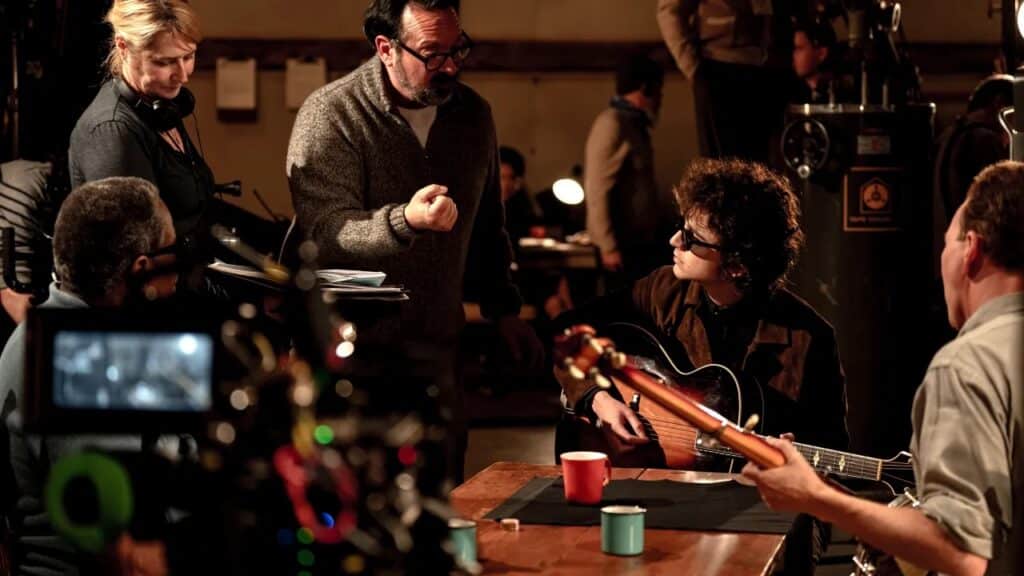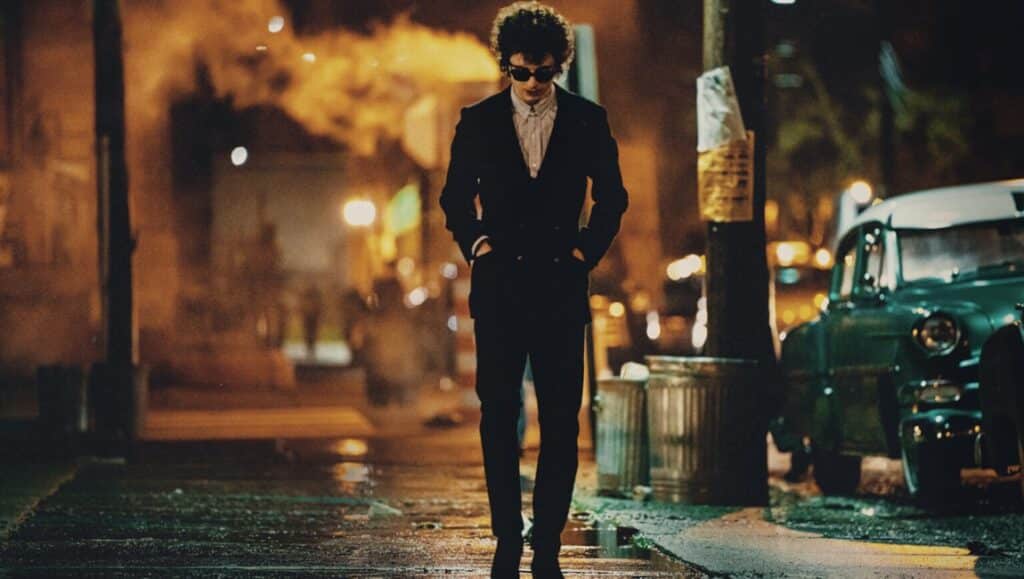“A Complete Unknown,” says the title of James Mangold’s film. That’s exactly what Bob Dylan was when he arrived in New York in 1961, at 19 years old, with his guitar in hand. The phrase is also a translation of a line from his iconic song Like a Rolling Stone. But do we really know more about him today? Not really. The phrase now seems to reflect a desire for anonymity. And for Dylan, that manifests in his rarity in photographs.
The film revisits the meteoric rise of the artist, portrayed skillfully by Timothée Chalamet. The role has already earned him a nomination for Best Actor at the Oscars, with the ceremony set to take place on March 3 in Los Angeles. Released in French theaters on January 29 and widely praised by critics, the film is headed straight for success.
Let’s go back to the “unknown” in the title. In 1961, Bob Dylan made his way in Manhattan with his songs—lyrical realism that brought a fresh wave to folk music. No one could have imagined that this brilliant chameleon would go on to electrify (literally) the genre and leave an indelible mark on music history. Even less expected was how quickly it would happen. In just five years, Bob Dylan went from a complete unknown to too well-known—at least, in his view.

Frenzied fans
The 1960s also saw the rise of a new phenomenon in music: the fans. A growing hysteria—intense, physical, tactile, and… loud. The impenetrable Bob Dylan experienced it as something overwhelming, even frightening. And the peak of this madness came in 1966.
“That same year, the Beatles stopped performing live because they could no longer hear themselves in concert. As for Bob Dylan, he had a motorcycle accident and vanished completely for months,” notes Nathalie Lambert, an art advisor responsible for one of the largest collections of Bob Dylan photographs, owned by David Walker.
Dylan eventually resurfaced but sought peace in the countryside of Woodstock. He later boycotted and avoided the legendary festival that, in 1969, set up its stage not far from his home. The organizers had certainly hoped to have their ultra-famous neighbour as the main act.
Betrayal
That same year, the official festival photographer, Elliott Landy, did a photo series at Bob Dylan’s home. In a unique and rare event, Dylan opened the doors of his Woodstock house. The musician allowed himself to be photographed, revealing his daily life, his partner, and his children. They are seen playing, jumping on a trampoline—a doting musician father, with his guitar never too far away.
This was far from the brooding image already attached to him. The artist exuded a simple serenity, and no corner of his forest home escaped the photographer’s lens. During a stroll, Dylan picked up a hat, leaned toward the photographer, shielding the sun, and seemed to greet him with a smile. That photograph became the cover of his ninth album, Nashville Skyline.
But the bond between the two men, so evident in the images, could not withstand what Dylan saw as a betrayal. Elliott Landy later published everything in a book—without Dylan’s permission. They never spoke again.
Disappearance
The unknown of the film’s title then began to take on real-life meaning for Bob Dylan. A sort of Greta Garbo syndrome took hold, isolating the star and making him avoid cameras altogether. It took him months to collect his Nobel Prize in Literature in 2016, and no one really knew why. There was no chance he would appear at the awards ceremony itself, which was filmed and broadcast worldwide.
Since he continues to perform live, the stage has at times become a challenge. “Bob Dylan has gone more than 30 years without being photographed at concerts,” points out Nathalie Lambert. The artist dodges unauthorized pictures by positioning himself behind his piano or structural pillars. He has even left the stage upon spotting a camera aimed at him from the audience, as he did in Berlin. On other occasions, he has performed with his back to the audience, much to the dismay of some fans on his tours.
Things naturally became more complicated when cameras landed in everyone’s hands and pockets—via smartphones. Dylan is far from the only artist who despises the sea of black rectangles held aloft in the crowd. This problem soon led to a business opportunity, which the company Yondr seized in 2014.

No-phone
American entrepreneur Graham Dugoni invented a flexible pouch, distributed at event entrances, in which attendees must place their smartphones. The pouch is then sealed using a magnetic lock. While the phone stays with the owner, it remains inaccessible until the event ends. Emergency access is available if necessary, and at the exit, the pouch is demagnetized so the device can be retrieved.
Artists in the U.S. quickly adopted it in 2015. But Yondr’s invention found further applications in schools, workplaces, film sets, rehearsals, and even courtrooms. The company expanded globally, opening offices in Dubai, London, and Sydney.
Naturally, these pouches have been implemented at Dylan’s concerts—including in Paris in 2022 and London in 2024, as confirmed by Nathalie Lambert.
Beyond controlling his image, advocates of the no-phone policy argue that it allows people to fully experience the moment. This is the principle behind Belgium’s Voodoo Village electronic music festival in Grimbergen, which obstructs smartphone cameras to encourage real engagement with the performances.
Rarity and quality
“At Dylan’s concerts, it’s true—without the distraction of photos, you find yourself surrounded by darkness, entirely focused on the music. I appreciated that aspect; you live in the present moment,” recalls Nathalie Lambert. Some decry no-phone policies as an infringement on personal freedom, and Dylan’s reputation for irascibility has grown over the years. But this rarity also has its merits.
For collectors, it adds intrigue: “Building a photography collection around someone who refuses to be photographed—well, that’s something,” Lambert muses. For Italian fan Paolo Brillo, it has become an obsession. For years, he has found ways to outmaneuver security and capture Dylan on stage. His work is, in some ways, valuable—preserving key moments for history.
And finally, consciously or not, Bob Dylan has achieved something many of us chase: eternal youth. At least in photographs. The most documented period of his life remains his early years, with most references to him drawing from that initial, often black-and-white archive.
Hats off, Mr. Dylan—at 83, you haven’t aged a bit!

